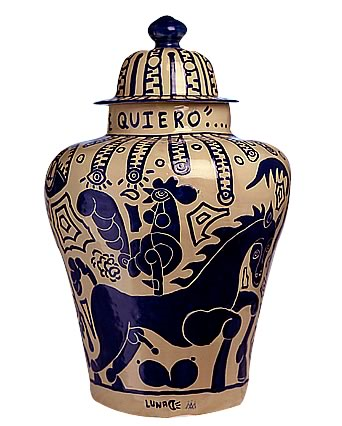The Work of Carlos Luna
By Osvaldo Sánchez ©
The work of Carlos Luna constructs itself over the whole basic, residual repertory of Seventies Cuban art, more specifically on the Pop models of print-
The generation of the Eighties, to which Carlos Luna belongs, strove to abolish the representative complacency of the Seventies and its saccharine fondness for making any ever image into the visual panacea of our idiosyncrasy. However, Luna did more than to take up those minor keys of national discourse such as the bucolic, the everyday anecdote, the provincial picturesque, the heroes of Independence, and a certain mystical exaltation. He also reduced the theoretical challenges of his approach to the personal imagery of someone who grew up in a small tobacco town. This is a highly unusual feature in the visual arts panorama of the Eighties in Cuba.
Despite the fact that many of the resources marshaled by Luna are already documented in the work of Seventies print-

The immoderateness with which Luna piles on the hatching and striping, his spiraling or oblique compositions, the contrast between figure and ground, the intense lighting and the vibrant planes of color; all these are reminiscent of the festive popular murals painted on the tin sheets of the guaraperas, or cane juice vendors; on the back of the buses, on plaster spray-
The only affinities between Carlos Luna and the rest of his generation reside in the careful design of his compositions and in certain plastic elements similar to those of José Bedia, Tomás Esson and other common sources. Nevertheless, Luna´s vivacious Pop spirit and strident graphism remind us, at their best, of the major paintings by Umberto Peña, suffused with the illustrative kitsch of lesser artists such as Ludovico or Larrinaga.
Carlos Luna´s sojourn in Mexico over the last few years has reaffirmed his interest in popular artifacts, the intimate wit of toys, and the redecorated exaltation of low-
It may be that Luna’s penchant for making works based on quotations from and tributes to masters and colleagues, constitutes his way of legitimating certain common sources and deliberate borrowings, which converge in the popular baroque, in kitsch and in decorative arbitrariness. It is a perpetual proclamation, from the crude stage of a village childhood, of his nostalgia for a party, which is over.
Mexico, DF 1995

